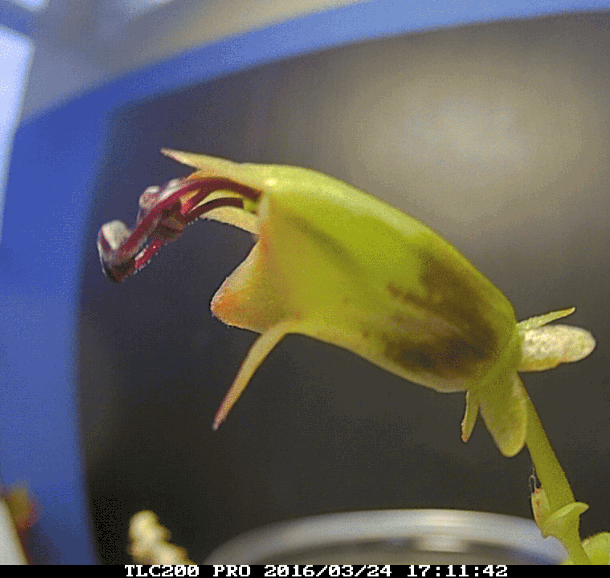top of page
Pollination of Aeschynanthus acuminatus (Gesneriaceae)
by generalist passerines in sunbird-absent East Asia
Work by Jing-Yi Lu*, Kai-Hsiu Chen* and Chun-Neng Wang
* This research was at IBC 2017 (Poster section): abstract T2-53-15
* This research was at TSPB Conference 2016 (Poster section), TSPS 2017 (Oral presentation), CABE 2018 (Oral Presentation).
Why Aeschynanthus acuminatus?
Floral morphology:
Most species in the genus Aeschynanthus has flowers with typical bird pollination syndromes: red and long corolla tubes, large and dilute nectar, and narrow throat at the base of their corolla tubes. However, A. acuminatus has the anomalous flowers shapes and corolla color. It has a green color, sometimes with faints of reddish color on corolla lobes in Taiwan (It actually shows a variation in color among different populations). Comparing to its relatives, the corolla lacks the throat that believed to mechanically fit with the narrow beaks of sunbirds. The weird characters lead to difficulty in assigning to any pollination syndrome.
Geographic distribution:
A. acuminatus has possibly the widest distribution among all the congener species, ranging from India, Indo-China, southern China to Taiwan. It also occurs at the northmost boundary of the distribution of the genus.
When overlapping the distribution with the putative pollinators of the genus, sunbirds, things get more interesting. The species is the only known case to extend beyond the sunbird distribution. The lack of sunbirds in Taiwan (which is also a mysterious fact) doesn't hold back the thrive of this species on the island.

Reproductive success and the conundrum
A. acuminatus is a common member of the humid subtropical lowland rainforest in Taiwan. As an epiphyte, it doesn't get too much attention. But when it comes to the fruiting season (from March to August), sometimes its abundant dehiscent fruits and tiny seeds flying in the sky are hard to be neglected. From observation, the natural fruit sets rate is high, and the small seedlings are easy to be found throughout wet forest floors. The reproductive success in this species is seemly high.
As it crosses the broader of sunbird distribution, how does it retain or even enhance such reproductive success comes as a conundrum. This conundrum led to several hypotheses: Is the species change its pollination partner and if that is the case, is the pollinator shift correlated with the strange floral morphology? Or, the species adopted different reproductive strategies, such as autonomous selfing, which is common in island flora? And if the pollinator shift did occur, is the pollination effectiveness drop as it utilized a more generalized pollination syndrome with more interspecific interference similar to common phenomena in flora lack of specialized pollinators.
Flowers of A. acuminatus are protandrous, which means the male organs mature first and then female parts came next. From the direct observation and pollination experiments (Unpublished data), there's no evidence that autonomous selfing occurs in the reproductive strategy of A. acuminatus. The time-lapse video on the right demonstrates the progress of flowering of A. acuminatus, both characters mentioned above could be observed in this clip. Thus, the hypothesis of obligate selfing can be ruled out, and high reproductive success comes from pollination success by the contribution of pollinators.


Pollinator observation
To reveal the pollinator assemblages of the species, pollinator observations were conducted at San Xia (三峽) region in February to March. To include possible nocturnal pollinators such as bats and moths, we set up the video camera at Qing Shui Bridge (清水橋) on three individuals for 24-hour recording over 48 hours in total.
Direct human observation was also performed over 10 hours in total throughout the day. These observations focus on over 10 clusters of individuals at both QS Bridge (清水橋) and Manyueyuan (滿月圓).
The pollinators turn out to be generalist passerines. Four species of passerines were identified around the clusters of A. acuminatus. The flocks of passerines mainly visited in the early morning when the sunlight went through the dense canopy and lightened the understory.

Among them, Pomatorhinus ruficollis (小彎嘴畫眉) only shuttled around the flowers but no direct visiting has been observed.
The visiting of Yuhina brunneiceps (冠羽畫眉), Alcippe morrisonia (繡眼畫眉) and Heterophasia auricularis (白耳畫眉) were recorded and observed. Their visiting behavior and movements illustrate that they're effective pollinators.
A short cut of recording clips on the left demonstrates the typical visiting behavior of Y. brunneiceps (冠羽畫眉) including both perching and hovering. The obvious pollen spot on the crest could also be found in this clip.
More details to come after the publication of our work.
Presentation at CABE 2018
Our research was selected to be presented at the symposium of "the interaction between aminals and other organisms" of the Congress of Animal Behavior and Ecology 2018, Hsinchu, Taiwan.
Here is the video recording of the 15-min presentation (in Chinese) to have a glimpse of the research.
The video was recorded and the copyright belongs to the CABE 2018.
Copyright © 2016 J-Y Lu, K-H Chen, and C-N Wang. All rights reserved.
No copy or use of any media or information on this page are allowed without permission by the authors.
bottom of page